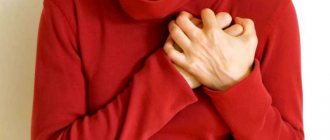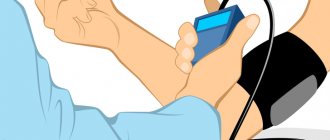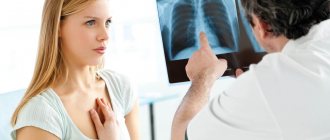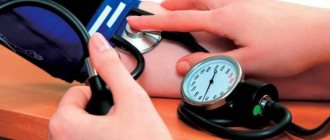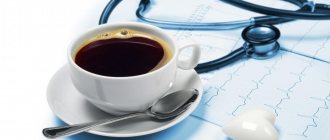Causes of rapid heartbeat
A rapid pulse may be a reaction to external stimuli or indicate the development of diseases of the cardiovascular system and endocrine glands. A general list of reasons for an increase in heart rate (HR) is as follows:
- excessive physical activity (in training, work);
- stress;
- lack of nutrients;
- hemodynamic failures;
- endocrine disorders;
- pathologies of the heart and blood vessels;
- colds accompanied by high fever;
- exposure to medications;
- alcohol consumption;
- smoking;
- abuse of caffeine and energy drinks.
Physiological arrhythmia can be eliminated by consulting with a specialist about discontinuing certain medications, adjusting your work and rest schedule, and changing your diet. In the case of pathological causes of the problem, you will have to resort to drug treatment. It is compiled based on the diagnostic results.
How to lower your heart rate
Many people experience bouts of heart palpitations, so they are naturally concerned with the question: how to reduce heart rate? Here it is important to separate reduction methods aimed at relieving an attack, and regular treatment methods designed to save them from occurring.
In the first case, you should calm down, lie down and take off your restricting clothes. Then you should hold your breath while exhaling for 30 seconds. You should exhale gradually. You can also close your eyes and press lightly with your fingertips on your eyeballs (with your eyes still closed). It is necessary to drink a sedative (valerian, motherwort, valocordin). A drink, preferably carbonated, will also help.
If we talk about drug treatment, the following groups of drugs are usually prescribed:
- Sedatives of natural or synthetic origin;
- Antiarrhythmic drugs.
You should also change your lifestyle:
- Reduce consumption of coffee and alcohol;
- Stop smoking;
- Maintain a daily routine and avoid overwork.
Why are the symptoms dangerous?
If there is not enough air, that is, it becomes difficult to breathe, and a rapid heartbeat appears, then we can talk about the development of a dangerous pathological process. The problem is most often associated with heart failure and coronary artery disease. In the first case, a person experiences shortness of breath (dyspnea), which intensifies with physical activity, and the pulse quickens due to the inability of the heart to provide adequate blood supply to the body. With ischemia, tachycardia develops due to impaired patency of the coronary vessels due to the development of atherosclerosis.
There are other causes for shortness of breath and rapid heartbeat:
- vegetative-vascular dystonia (VSD);
- myocardial infarction;
- panic attack;
- stroke.
Pathological causes are dangerous due to their complications. Constant hemodynamic disruptions lead to the formation of blood clots and dysfunction of internal organs.
If your heart beats strongly and it’s hard to breathe after stress, taking medications and physical overload, then the problem lies in the influence of physiological factors. This reaction often occurs in older people. The symptoms that arise can be eliminated by changing your lifestyle.
Prevention of cardiac dyspnea
The best way to combat a disease is to prevent it - prevention.
Primary measures are aimed at eliminating factors that can negatively affect the respiratory system. Risks of dyspnea include:
- Obesity;
- Sedentary lifestyle;
- Tobacco smoking;
- Harmful working conditions;
- Poor nutrition;
- Alcohol abuse.
90% OF PEOPLE HAVE GASTRITIS AND ULCERS - IS THIS A STORM OF THE STOMACH?
Constant or intermittent abdominal pain, which can radiate to the left or right side. Is it sharp, aching, dull, pulling or sharp? All these symptoms are familiar to you firsthand.
Aching, nagging pain under the rib on the left may indicate the presence of a purulent-necrotic focus. The most vulnerable areas are the stomach, spleen, sub-rib.
Our heart often reports any problems in the body with a rapid pulse. This phenomenon is called “tachycardia”. The causes of rapid heartbeat are of different nature and may differ in individual people due to their lifestyle, health and other factors affecting the condition of the body. What causes the heart rate to exceed the normal number? The instructions below will help you learn more about this phenomenon.
Why does it start to take your breath away?
Difficulty breathing (shortness of breath) is a sign of the body's adaptation to new conditions. In this case, it is not necessary that the person will suffocate, since the resulting hypoxia can be stopped by a rapid heartbeat. This phenomenon often occurs when working in breathing apparatus, rapid ascent and carbon monoxide poisoning.
Dyspnea is divided into expiratory and inspiratory. The first is characterized by difficulties when exhaling, and the second - when inhaling.
Most breathing problems are physiological:
- psycho-emotional stress;
- physical overload;
- staying in a poorly ventilated place.
Voiced breathing difficulties manifest themselves reflexively and go away on their own. Most often, an attack of tachycardia and shortness of breath occurs in obese people as a reaction to stress. In athletes, such symptoms are found much less frequently.
The pathological form of shortness of breath manifests itself even at rest and intensifies with physical exertion. The patient must be given all possible assistance (call an ambulance, take steps to stabilize the condition) in order to avoid consequences. The general list of reasons is as follows:
- pathologies of the respiratory system;
- cerebral causes;
- changes in blood composition;
- diseases of the cardiovascular system.
Heart muscle diseases
Usually the heart beats quickly and it is difficult to breathe in the presence of pathologies of the cardiovascular system:
- cardiomyopathy;
- heart failure;
- developmental defects;
- irregular heartbeat;
- inflammatory diseases of the membranes of the heart.
Cardiac dyspnea manifests itself with severe symptoms:
- sweating, a feeling of lack of air and weakness appear;
- swelling occurs in the lower extremities;
- your head begins to feel dizzy and your heart begins to pound;
- skin turns blue;
- there is a feeling of anxiety and tightness in the chest.
The most common cause of shortness of breath is heart failure. Against this background, pulmonary edema may develop, which is characterized by the following symptoms:
- increased respiratory rate;
- enlargement of cervical vessels;
- cough with foamy sputum;
- blue face.
The essence of therapy is to eliminate the causative factor, relieve the load on the heart muscle and stabilize its rhythm. The following medications are usually prescribed for long-term use:
- adrenaline blockers;
- cardiac glycosides;
- diuretics;
- angotensin-converting enzyme inhibitors.
Pathologies of the respiratory system
In diseases associated with the respiratory system, shortness of breath can occur both during inhalation and exhalation:
- proliferation of tumors;
- entry of foreign bodies into the respiratory tract;
- blockage of blood vessels by blood clots;
- chronic pathologies: pneumosclerosis;
- bronchitis;
- emphysema;
- inflammation of the larynx affecting the vocal cords;
- asthma;
- pneumoconiosis.
The clinical picture for respiratory diseases is usually as follows:
- shortness of breath, developing into suffocation;
- cough;
- secretion of sputum and blood;
- pain in the chest and neck area.
The course of treatment is drawn up depending on the causative factor:
- If a foreign body enters the respiratory tract, the patient must be given first aid in order to get it out faster.
- Allergic pulmonary edema is eliminated by the use of glucocorticoids, antihistamines and adrenaline.
- They save from asphyxia (suffocation) by performing tracheotomy and conicotomy.
- For asthma, you should take drugs representing the groups of beta-adrenergic agonists, glucocorticosteroids and anticholinergics.
- Inflammatory processes are eliminated using antibacterial and detoxification treatment.
- Tumors, pneumothorax and hydrothorax are treated with surgery.
Cerebral factors
When the brain is damaged, the heart beats strongly and it becomes difficult to breathe due to the localization of the most important regulatory centers of all departments and organs in this area. The reasons are usually the following:
- stroke;
- head injury;
- encephalitis;
- tumor.
The mentioned factors are characterized by severe neurological symptoms (impaired cognitive functions, paresis, paralysis, dizziness, headache, signs of paresthesia). The degree of recovery depends on the effectiveness of treatment and the severity of the pathological process.
Sometimes cerebral dyspnea occurs due to a malfunction in the autonomic nervous system caused by stress and mental overload. It manifests itself as follows:
- lack of air;
- panic attack;
- surges in blood pressure and pulse;
- excessive sweating;
- general weakness.
The treatment regimen depends on the cause. A combination of drug treatment and surgery is often required. Disturbances in the nervous system are treated with sedatives.
Violation of blood composition
Changes in the composition of the blood are observed in the following cases:
- anemia;
- oncological diseases;
- renal and liver failure;
- diabetic coma.
The patient feels short of air, but there are no changes in the lungs and heart. The examination reveals disturbances in the electrolyte and gas balance.
The course of therapy is aimed at combating the causative factor, saturating the body with useful substances and correcting nutrition. Liver or kidney failure is treated with detoxification and infusion treatment.
There are other causes of shortness of breath that are not related to the heart, lungs, blood and brain:
- intervertebral hernia;
- osteochondrosis;
- intercostal neuralgia.
It becomes difficult and painful for patients to breathe. Discomfort increases when moving. Therapeutic exercises and anti-inflammatory drugs are prescribed as treatment.
Expectant mothers experience breathlessness and increased heart rate due to the growth of the uterus. In the early stages, such symptoms do not actually appear, but closer to the 3rd trimester, discomfort becomes noticeable.
Causes and methods of eliminating them
Breathing problems, along with a rapid heartbeat, can develop for various reasons. If shortness of breath occurs, a person will not necessarily begin to choke, because his body can try to eliminate the lack of air by increasing the heart rate. This often happens when working with breathing apparatus, carbon monoxide poisoning and a fairly rapid rise to altitude.
Thus, among the most common causes of breathing problems and rapid heartbeat, it is worth highlighting:
- physical stress;
- psycho-emotional stress;
- lack of oxygen due to external factors.
Such problems arise reflexively, do not pose any particular danger and most often go away without medical intervention.
Often, an attack of tachycardia and breathing problems are observed in people who are overweight, as a reaction to physical overexertion.
First aid
With pathological shortness of breath, failure of breathing can overtake a person even at rest, without the influence of any external factors on the body. In this case, the patient usually needs first aid to stabilize breathing.
Standard actions for an attack of tachycardia and shortness of breath include:
- Take a half-sitting body position . The legs should be lowered down.
- Calm down . Panic will only make the situation worse.
- Loosen clothes . Unfasten or remove anything that prevents you from breathing freely.
- Make sure there is sufficient ventilation in the room . If necessary, open windows or use special items such as an oxygen tank.
- To take medicine . To eliminate palpitations, you can use nitroglycerin tablets and cardiac glycosides.
Often a person is able to provide such help to himself. In case of particularly severe attacks, you will need to call an ambulance.
Pathologies of the cardiovascular system
Rapid heartbeat and heavy breathing can occur due to problems with the cardiovascular system, the most common of which are:
- heart failure;
- cardiomyopathy;
- inflammation of the heart membranes;
- acute coronary heart disease;
- developmental defects.
Coronary heart disease and heart failure are more often the causes of this condition of the body. In the first case, tachycardia develops due to disruption of the patency of the coronary vessels due to atherosclerosis. In the second case, due to the inability of the heart to maintain the level of blood supply necessary for the body.
Cerebral factors
Increased heart rate and breathing problems with brain damage are observed due to the localization of control centers of all organs and parts of the body in it. This happens in most cases for the following reasons:
- head injury;
- stroke;
- tumor;
- encephalitis.
Along with tachycardia and heavy breathing, with such problems with the body, neurological symptoms such as dizziness, paralysis, disruptions in the cognitive system, and so on are also noticeable.
The possibility of recovery from such brain disorders depends on the degree of damage to the organ and the effectiveness of the treatment provided.
Often, shortness of breath due to cerebral factors is caused by a malfunction in the autonomic system, which can occur due to stress and excessive mental strain. This body reaction is complemented by:
- panic attacks;
- increased sweating;
- fluctuations in pulse and blood pressure;
- general weakness.
In this case, therapy depends on the cause of such a disorder. Often, drug treatment is combined with surgical intervention. Problems with the nervous system are relieved with various sedatives.
Breathing problems and rapid heartbeat can also occur for other reasons: vegetative-vascular dystonia, intervertebral hernia, intercostal neuralgia, osteochondrosis.
Quite often, when moving, such problems only get worse. Anti-inflammatory drugs together with therapeutic exercises help well in cases of such diseases.
Due to physical overexertion and stress, disruptions in the functioning of the respiratory system during tachycardia often occur in older people.
Pregnant women also often suffer from similar dysfunctions of the body. This is explained by physiological factors. In this case, in addition to drug intervention, the symptoms that arise can be eliminated through lifestyle correction.
What to do if you have a rapid heartbeat and shortness of breath?
At home, the following tips will help alleviate the condition:
- If the condition worsens indoors, then you need to open all the windows and lie down. It is advisable to remove clothing that is constricting your chest to make breathing easier.
- Take Valocardin or a sedative tincture (hawthorn, motherwort) to calm and dilate blood vessels.
- Breathe slowly and deeply. Inhalation should be done 1.5-2 times faster than exhalation.
- Holding your breath or coughing will help reduce your heart rate.
Frequent attacks of tachycardia and shortness of breath should be a reason to visit a cardiologist or therapist, especially if they are accompanied by other symptoms. This condition may be a harbinger of an impending heart attack or stroke.
You should visit a doctor as soon as possible if you have the following symptoms:
- a feeling of lack of air occurs under any load;
- weakness and dizziness appear;
- the attack begins for no reason and does not go away for a long time;
- serious disturbances in the heartbeat occur.
What to do first
When such conditions occur, a person may become frightened, which can cause even stronger heart palpitations. What to do when your heart beats fast? How to help a person?
There are medicinal and non-medicinal methods of providing first aid. The first involves taking Corvalol or Valocordin.
In addition, you can use a non-drug method to relieve pain:
- Contract the muscles of your lower limbs and abdomen for 15 seconds. After that, relax. After a couple of minutes, repeat the exercise;
- Try to focus your gaze on one point;
- Massage the tips of the little fingers on both hands;
- Take a deep breath and hold your breath. After 5-10 seconds, exhale slowly.
Rapid heartbeat during pregnancy is a fairly common phenomenon. Doctors usually talk about the patterns of certain disorders in the functioning of the heart muscle, since it must ensure blood flow to the uterus.
In addition, anemia is most often the cause of heart palpitations during pregnancy. Other factors include excess weight, thyroid disease, bronchial asthma, allergic reactions to foods and medications, stress, and physical strain.
As a rule, expectant mothers who experience heart palpitations are first advised to reconsider their lifestyle: spend more time in the fresh air, perform special exercises, follow a diet, and avoid stress.
In severe cases, when palpitations are accompanied by shortness of breath, headaches, a sharp increase or decrease in blood pressure, the doctor prescribes medication.
A rapid heartbeat in a child is insidious because it can lead to the development of serious heart pathologies in the future.
However, in order to determine the presence or absence of tachycardia in a child, it is necessary to know the physiologically normal number of contractions. So, in a newborn baby, the heart makes 160-180 beats per minute. By the age of one year, a heart rate of 130-140 beats per minute is considered normal. After 5 years, the child’s pulse is 80-130 beats per minute.
A rapid heartbeat in a child refers to several conditions of the heart muscle:
- Sinus tachycardia, observed in thin children with poorly developed muscles. It is caused by heart disease, diseases accompanied by fever, and physical activity. Typically, this disease does not require special treatment (it goes away as you grow older), but requires systematic monitoring by a cardiologist;
- Paroxysmal tachycardia that occurs suddenly. Moreover, the heart begins to beat 2-3 times faster. Signs of the disease appear, such as pulsating veins, shortness of breath, and possible bluishness of the skin and mucous membranes. The child may get scared, which can cause the condition to worsen. The attack is relieved by intravenous injections of glycosides, for treatment - potassium chloride;
- Chronic tachycardia, characterized by systematicity. The cause of chronic tachycardia is congenital heart pathologies. Symptoms of this condition: headache, weakness, shortness of breath, chest pain.
Since the child’s body is extremely dynamic, rapidly developing and changing, rapid heartbeat can have a unique character and the causes of its occurrence are not always clear-cut.
Lifestyle and environment are of great importance for normalizing a child’s heartbeat.
At the time of an attack, rest should be ensured, the patient should be laid down, and a flow of fresh air should be provided.
To alleviate the condition yourself, you need to do the following:
- stop physical work, try to calm down;
- open a window to let in fresh air or go outside;
- put something cold on your forehead (a wet napkin or towel, a bottle of water);
- relax, take a comfortable position;
- breathe deeply, with quick inhalations and slow exhalations;
- you can try to reduce your heart rate by coughing;
- You need to hold your breath for a few minutes and tense your abdominal muscles;
- induce vomiting by pressing on the root of the tongue;
- immerse your face in cold water;
- apply strong and sharp pressure at the angle of the lower jaw;
- take drops (Corvalol, valerian or Valocordin);
- if a person has difficulty breathing, you need to give him an oxygen bag;
- if the condition does not improve, call an ambulance.
If there is not enough air and your heart rate increases, you need to consult a therapist or cardiologist. Perhaps the patient will be referred to another specialist, since these symptoms are not always characteristic of cardiac diseases.
You can also read: Treatment of tachycardia during pregnancy
Sedatives will help you calm down and reduce your heart rate.
Diagnostic methods
For a doctor, a rapid heart rate combined with a feeling of shortness of breath is only a sign of a certain disease or pathological condition. He will interview the patient and conduct an examination, then prescribe a series of examinations to find the causative factor:
- blood and urine tests;
- radiography;
- computed and magnetic resonance imaging (CT and MRI);
- electrocardiogram (ECG);
- Ultrasound examination (ultrasound) of the heart.
Additionally, you may need to do daily ECG monitoring and bicycle ergometry. The first examination will show the work of the heart during the day, and the second during exercise. Based on the diagnostic results, the doctor will make a diagnosis or refer you to a more specialized specialist (neurologist, endocrinologist).
When to make an appointment with a doctor
A rapid heartbeat is a reason to see a doctor if it:
- too intense;
- is protracted (does not go away for a long time);
- occurs with less and less exposure to the above factors;
- occurs independently of the above factors;
- is uneven in nature (arrhythmia can be assumed - a violation of the heart rhythm).
In these cases, rapid heartbeat may be a manifestation of serious disorders and diseases, such as:
- avitaminosis;
- anemia (low hemoglobin and iron in the blood);
- tetany (a condition caused by a lack of calcium);
- endocrine diseases;
- heart pathologies.
However, as a rule, in the case of myocarditis, other heart diseases, and hyperthyroidism, palpitations are not the main complaint. With such diseases, first of all, they complain of pain in the heart and shortness of breath.
It is necessary to react promptly if, against the background of increased heartbeat, dizziness, shortness of breath, pale skin, and sweating are observed. In this case, you should call an ambulance.
You should definitely contact a cardiologist if:
- heartbeat is intense and frequent;
- begins acutely for no apparent reason and does not go away for a long time;
- it’s hard to breathe even with small loads;
- palpitations are accompanied by dizziness, weakness, loss of consciousness;
- The heart rhythm is disturbed, a feeling of missing beats appears.
Features of treatment
It is necessary to treat not the increased heart rate and shortness of breath, but the causes that cause these symptoms. The treatment regimen is drawn up depending on the underlying pathological process. Medications, physical therapy, and surgery may be required. It is necessary to combine the main course of treatment with lifestyle corrections and avoidance of irritating factors.
The following groups of drugs are used as symptomatic treatment:
- calcium channel blockers;
- diuretics;
- sedatives;
- adrenaline blockers;
- sartans.
Medicines can reduce nervous excitability, restore the usual heart rhythm, reduce myocardial oxygen demand and stabilize blood pressure. They should be used strictly according to the scheme drawn up by the attending physician. It is prohibited to use antiarrhythmic drugs on your own.
The combination of lack of air and rapid heart rate is most often a consequence of the influence of physiological factors. It is enough for the patient to avoid them to improve the condition. If the symptoms that arise appear against the background of pathology, then you will have to use therapeutic agents to eliminate them. Before starting a course of therapy, it is necessary to be fully examined to accurately determine the causative factor.
Why do they occur?
PA as an independent disease has been studied for about 40 years, but the exact causes of this phenomenon have not yet been established. At the moment, we have only been able to identify the factors contributing to a panic attack:
- Psychogenic – stressful situations or events, strong impressions, conflicts.
- Biological – hormonal imbalance caused by the characteristics of the menstrual cycle and pregnancy in women, and the use of hormones. Endocrine diseases are not included here.
- Physiogenic – drug use, alcohol intoxication, physical overexertion, acclimatization, excessive insolation. Drugs such as Prednisolone, Cholecystokinin or Bemegride can also provoke panic syndrome.
